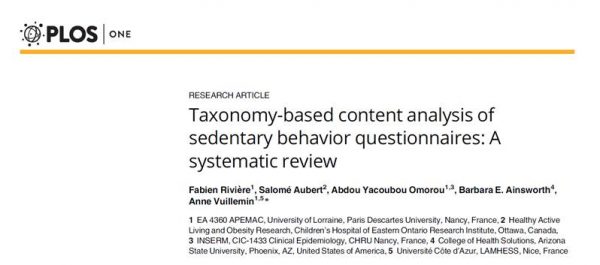
Benefits to heart health of reducing workplace sitting
February 16, 2018
Taxonomy-based content analysis of sedentary behavior questionnaires: A systematic review
March 21, 2018Today’s post comes from Professor Stuart Biddle, of the University of Southern Queensland. More on Professor Biddle, and links to papers cited in this article, can be found at the bottom of this post.
I have been studying sedentary behaviour for some time now. In 2001 we were funded by the British Heart Foundation to study sedentary behaviour patterns in teenagers (e.g., Gorely, Marshall, Biddle, & Cameron, 2007). At the same time we decided to conduct a number of systematic reviews on this and related topics. Up to this time the focus was on TV viewing and little else. Many were claiming that we fattened up kids by too much TV. Seems logical. But the more we studied this area, the more complex it seemed to get and that the obvious conclusion assumed by many seemed rather naive. In fact, in our 2004 meta-analysis on the topic, we found a very small association between TV viewing and body fat measures in young people. The overall effect size (from correlation coefficients) using 52 samples, was only 0.066. Although significant according to the confidence intervals, we questioned whether such a value was clinically meaningful (Marshall, Biddle, Gorely, Cameron, & Murdey, 2004).
Fast forward some 13 years to the other side of the world from the UK – Australia. I was still thinking about sedentary behaviour, screen time and weight status, among other issues. Of course, times had moved on with rapid advances in screen-based technology, and the literature was growing exponentially as far as health outcomes of sitting was concerned. But people were still saying that TV, and other screens, or just ‘sitting’, were making kids fat. Was I wrong? This led me to think that maybe I could produce a reasonably definitive analysis and statement on the topic. First, I needed to update and analyse the evidence. We first undertook a review of reviews on sedentary behaviour, screen time and adiposity in youth (Biddle, García Bengoechea, & Wiesner, 2017). Believe it or not, we analysed 29 systematic reviews! And to think that I remember seeing one of the first meta-analyses in sport and exercise science come out in a journal in 1983! As part of our review of reviews, we also undertook an analysis of whether any relationship could considered causal. This was done by using criteria proposed for epidemiological research by Sir Austin Bradford Hill (Hill, 1965).
One of the key criteria that has been used to conclude that screen time does lead to obesity is the strength of the association between the exposure of sitting (e.g., TV, screens, total sitting) and the outcome of adiposity. Yet, we found consistently low strength of association values for adiposity from cross-sectional evidence for self-reported screen time and sedentary time measured with wearable technology. In fact, the latter were often close to zero. Moreover, prospective studies showed little association, and interventions showed only small, both significant and non-significant, effects. However, there was some evidence for a dose-response effect. In short, we could not conclude that sedentary behaviour ‘caused’ changes in adiposity even though this was claimed over 30 years ago (Dietz & Gortmaker, 1985).
Using the extensive evidence derived from the 29 systematic reviews, we tried to pull this together and make sense of the bigger picture. Our short paper in Exercise and Sport Sciences Reviews (Biddle, Pearson, & Salmon, 2018) was a critical discussion but one that tried not to completely dismiss the idea that too much sitting could have effects on adiposity. After all, the Bradford Hill criterion on ‘coherence and biological plausibility’ can be somewhat supported, at least at a logical level, and there are studies showing relationships. This led us to suggest that interpretation of the evidence has been somewhat mixed – some see ‘glass half full’ and others ‘glass half empty’. For example, small but significant associations have been interpreted either way in the literature.
Perhaps the key issue to emerge from our paper is that far from sedentary behaviour and adiposity being linked in a simple and obvious way, as some have claimed, we need to view the topic as ‘complex’. In the conceptual model we proposed, adiposity may be related to sedentary behaviour, and particularly certain types of behaviours (e.g. TV viewing), but this cannot be seen in isolation. We also need to know how physically active young people are, what their diet is (including during these behaviours), and what their sleep hygiene is. The adiposity of an adolescent, therefore, will depend on a multitude of interacting factors, with sedentary behaviour likely being just one of them. On this basis, we should not expect simple, consistent, 1-to-1 associations between sedentary behaviour and adiposity. So, do we fatten our kids at screens? As the title suggests, the answer can be yes, no, maybe or it depends! In short, it is complex. Let’s recognise this and not over-simply such a complex set of behaviours.
About the author

Stuart Biddle is an expert on physical activity and sedentary behaviour from the perspective of behaviour change. His research adopts a multi-disciplinary ‘behavioural medicine’ approach concerning physical activity (getting active) and sedentary behaviour (reducing too much sitting) with a particular emphasis on the measurement, prevalence, correlates and behaviour change elements of sedentary behaviour. In addition, he has interests in active living and mental health, research application (translation) and policy.
References
Biddle, S. J. H., García Bengoechea, E., & Wiesner, G. (2017). Sedentary behaviour and adiposity in youth: a systematic review of reviews and analysis of causality. International Journal of Behavioral Nutrition and Physical Activity, 14 43. doi:10.1186/s12966-017-0497-8
Biddle, S. J. H., Pearson, N., & Salmon, J. (2018). Sedentary behaviors and adiposity in young people: causality and conceptual model. Exercise and Sport Sciences Reviews, 46(1), 18-25. doi:10.1249/JES.0000000000000135
Dietz, W. H., & Gortmaker, S. L. (1985). Do we fatten our children at the television set? Obesity and television viewing in children and adolescents. Pediatrics, 75, 807-812.
Gorely, T., Marshall, S. J., Biddle, S. J. H., & Cameron, N. (2007). Patterns of sedentary behaviour and physical activity among adolescents in the United Kingdom: Project STIL. Journal of Behavioral Medicine, 30(6), 521-531.
Hill, A. B. (1965). The environment and disease: Association or causation? Proceedings of the Royal Society of Medicine, 58(5), 295-300.
Marshall, S. J., Biddle, S. J. H., Gorely, T., Cameron, N., & Murdey, I. (2004). Relationships between media use, body fatness and physical activity in children and youth: A meta-analysis. International Journal of Obesity, 28, 1238-1246. doi:10.1038/sj.ijo.0802706




